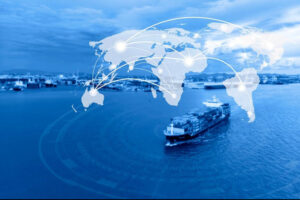 At 5pm, I can order a pair of shoes from London, and by 2pm the next day, they’ll be at my front door in Geneva.
At 5pm, I can order a pair of shoes from London, and by 2pm the next day, they’ll be at my front door in Geneva.
Beyond all other considerations, this speed and efficiency is impressive – and it’s made possible by seamless digital integration.
By automating manual processes, digitising bills of lading, integrating with customs, and offering a range of digital customer services, next-day delivery services have created a seamless experience, which in time will become commonplace across the broader logistics industry — including shipping.
Regardless of the complexity of change, physical documents, manual data entry, and isolated information are not suitable for a digital-first world.
A digital-first world needs a digital-first approach.
It’s not a matter of if, but when, and that ‘when’ is set to become sooner.
As governments and global trade organisations put a digital-first approach in their focus, the issue goes from being just a key theme in shipping, to an essential for the future of global trade.
New trade agreements, global policy recommendations, and data sharing initiatives all look to digitalisation as the way forward. The scope of digitalisation in shipping is moving from a tech-focused discussion to a total reimagining of how global trade will work in the future.
To see how we see our our digitalisation journey, I posted a LinkedIn poll to get your perspective. The consensus is that things are happening, but we’re just getting started.
It seems we can agree that things are starting to happen, so in this article I’ll explore several of these key initiatives that may suggest an acceleration in digital-first adoption is on the horizon.
This article is the first of a five part series exploring the five major themes affecting digitalisation in shipping.
Digital-first world, digital-first shipping
Recently, I spoke at a World Trade Organisation (WTO) and World Economic Forum (WEF) virtual conference called “The promise of TradeTech: Policy approaches to harness trade digitalization”.
The conference (and the paper of the same name) focuses on the important role technology plays in creating a more efficient, inclusive and sustainable global trade. It also outlines how policymakers can create a favourable ecosystem for widespread adoption and scalability.
The paper zeroes in on five core frontiers of policy, what it refers to as the 5 Gs of TradeTech:
- Global data transmission and liability frameworks
- Global legal recognition of electronic transactions and documents
- Global digital identity of persons and objects
- Global interoperability of data models for trade documents and platforms
- Global trade rules access and computational law
Of particular note is point four that stresses interoperability and standards. From e-invoicing, to transaction management, and government procurement, these standardisation initiatives are likely to converge and, in time, increase the uptake of digital in shipping.
As organisations like the WTO and WEF wield influence in setting policy, such policy papers have the potential to move the needle and push digitalisation up the priority list.
But it’s not just organisations that are talking digitalisation.
More trade. Less paper.
While policy directions play a critical role, trade agreements have clearly established terms, which makes them particularly influential in accelerating adoption.
In February this year, the United Kingdom and Singapore shared an outline of one such agreement. The Digital Economy Agreement (DEA) is “the world’s most innovative trade agreement, covering the digitised trade in services and goods across the whole economy”.
Central to the agreement is open and inclusive digital markets, data flows, and most notably for the logistics industry, digital trading systems.
Digital trading systems include modern electronic contracts, digital authentication, digital invoicing, paperless trading, digital customs and other areas concerning modern logistics — in other words, all the documents and processes needed to facilitate digital trade.
Such an agreement sets a precedent for a digital-first approach. And as one of the busiest transit ports in the world, Singapore’s adoption of such policies could soon become the standard with other countries, further accelerating adoption. As a member of the board, I’m looking forward to further exploring the opportunities it presents.
A digital data convergence
In March this year, the US government announced the Freight Logistics Optimization Works (FLOW). A major information sharing initiative, including representatives from all stakeholders of the supply chain to help speed up delivery times and reduce consumer costs.
Additionally, the Federal Maritime Commission (FMC) launched the Maritime Transportation Data Initiative with the goal of cataloging the status quo, identifying gaps, and developing recommendations to improve existing data collection and flows.
In summary, we’re seeing a convergence of focus towards a digital-first approach. Importantly, it’s not just those within the shipping industry – this has become a global trade priority.
As governments, influential organisations and other key stakeholders emphasise digital-first, a digital-first approach in shipping becomes a greater priority.
These are my predictions.
What do you see happening?
If our goal is being truly-digital first, what would you score the shipping industry out of 100?
What do you think it will take to speed up adoption of a digital-first approach?















